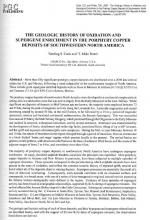Добрый день, Коллеги. Важное сообщение, просьба принять участие. Музей Ферсмана ищет помощь для реставрационных работ в помещении. Подробности по ссылке
The Geologic History of Oxidation and Supergene Enrichment in the Porphyry Copper Deposits of Southwestern North America
More than fifty significant porphyry copper deposits are distributed over a 2000 km interval within the U.S. and Mexico, following a trend subparallel to the southwestern margin of North America. These include giant supergene enriched deposits such as those at Morenci in Arizona (4.7 Gt @ 0.52% Cu) and Cananea (7.1 Gt @ 0.42% Cu) in Sonora, Mexico.
The porphyry copper deposits of southwestern North America were developed in a continental margin cratonic setting, above a subduction zone that was active largely from the Early Mesozoic to the Late-Tertiary. While significant ore deposits of Jurassic to Mid-Tertiary age are known, the majority were emplaced between 72 and 55 Ma, during the peak of magmatic activity along the Laramide Arc. Laramide magmatism and crustal shortening ceased by around 50 Ma, in the mid Eocene, to be followed by a 15 m.y. period of magmatic quiescence, erosion and localised continental sedimentation, the Eocene Epeirogeny. This was succeeded from around 35 Ma by the Mid-Tertiary Orogeny, which persisted through the Oligocene to the Early Miocene and resulted in renewed, widespread volcanism, and by crustal extension. Extension was characterised by the development of listric, detachment and strike-slip faults, associated listric tilting of up to 60° or more, and the uplift and exposure of metamorphic core complexes. During the Mid- to Late-Miocene, between 18 and 10 Ma, the nature of tectonism in the region changed through a period of transition, from an extensional to a block faulted 'basin and range' regime which persists locally to the present. The typical basins are grabens or half grabens, with structural relief between the base of sediment filled basins and the crests of the adjacent ranges of from 2 to 4 km, and sometimes more than 6 km.
The majority of porphyry copper deposits in southwestern North America have undergone supergene enrichment. At many, enriched sulphide blankets constitute the principal ores exploited. Most porphyry copper deposits in Arizona and New Mexico in particular, have been subjected to multiple episodes of supergene alteration. These episodes correspond to the periods during which sulphide minerals have been present in the zone of oxidation, and reflect the common tectonic history of repeated uplift, erosion and burial which all of the deposits share to varying degrees. Supergene processes are essentially the result of a form of chemical weathering. Consequently, each episode correlates with an erosional surface, and corresponds, in a broad sense, with one of a series of time-transgressive regional unconformities separating the Tertiary tectono-stratigraphic units defined in the region. Evidence of these episodes of supergene activity, has been found in stratigraphic relationships, supported by K/Ar dating of supergene minerals. The earliest affected the Jurassic Bisbee deposit in the Early Cretaceous. Subsequent contemporaneous supergene activity occurred during the: i) Eocene at Santa Rita, Tyrone, San Manuel (and Kalamazoo), Inspiration, Sacaton and Ajo; ii) Late Oligocene to Middle Miocene at Santa Rita, Tyrone, Red Mountain, Pinto Valley, Lakeshore and Silver Bell; and iii) Late Miocene to Pliocene at Tyrone, Morenci, Bisbee, San Manuel, Pinto Valley, San Xavier North, Silver Bell and Ajo.
The geologic and tectonic setting of each of these deposits, and their hypogene and supergene mineralisation are described herein, and with the support of 22 new K/Ar dates of supergene minerals, the observations listed above are derived.




